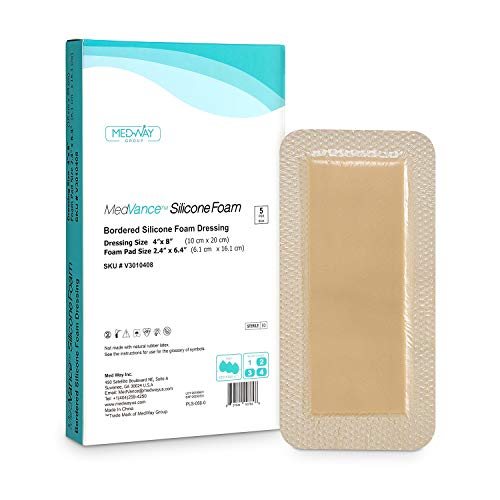Best Dressing For Skin Tear (2024 Update)
Choosing the best dressing for skin tears can seem overwhelming, but it doesn’t have to be. As we age, our skin becomes thinner and more susceptible to tears and wounds. Selecting an appropriate skin tear dressing is crucial for promoting healing and preventing infection. When exploring your options, consider factors like the location and severity of the wound, ease of use, and cost. The ideal dressing will protect the affected area, keep it moist to encourage healing, and allow you to monitor progress. Does the dressing need to be waterproof or absorbent? How often will it need to be changed?
Before making a purchase, ask yourself some key questions. Is your priority to prevent the wound from worsening or to reduce pain? Do you need a dressing that contains antimicrobial ingredients to prevent infection? Will you be changing the dressing yourself or relying on a caregiver? The answers will help guide you. Don’t be afraid to consult your pharmacist or doctor for personalized advice. With the right dressing, you can protect vulnerable skin and set the stage for healing.
10 Best Dressing For Skin Tear
| # | Product Image | Product Name | Product Notes | Check Price |
|---|---|---|---|---|
|
1
|
The product is ideal for securing primary dressings and medical appliances, and features perforations for easy tearing.
|
|
||
|
2
|
Ideal for natural and non-toxic first aid treatment of minor cuts, wounds, scrapes, rashes, sunburns, and other skin irritations.
|
|
||
|
3
|
Ideal for protecting and healing wounds with minimal to moderate exudate while providing a waterproof barrier.
|
|
||
|
4
|
It is an ideal product for wound dressing with its silicone-adhesive foam and border design.
|
|
||
|
5
|
It is ideal for providing soothing protection and creating a bacterial barrier for skin injuries or blisters.
|
|
||
|
6
|
The product is ideal for fast healing of blisters and wounds in first aid care.
|
|
||
|
7
|
This product is ideal for protecting wounds and incisions with a transparent film dressing in a picture frame style.
|
|
||
|
8
|
This product is ideal for people with sensitive skin who need a gentle adhesive tape that tears easily.
|
|
||
|
9
|
It is ideal for securing and protecting medical dressings or wound coverings.
|
|
||
|
10
|
The product is ideal for managing lightly exuding wounds with its flexible, sterile and self-adhesive dressing.
|
|
1. Medline Ez Tape – Dressing Retention Solution!
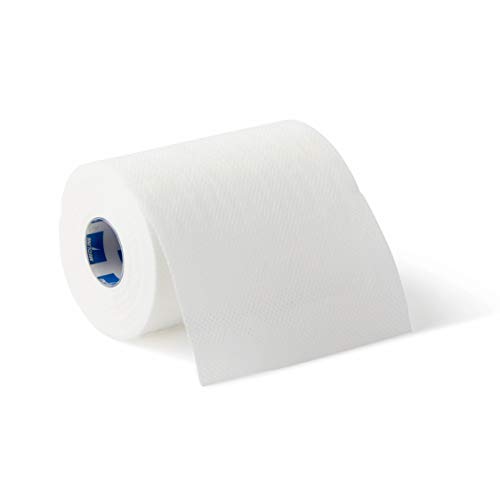
The Medfix EX Dressing Retention Tape is a reliable solution for securing primary dressings, as well as gastrostomy tubes and other feeding tubes. The tape is designed with a low-sensitivity adhesive that is gentle on the skin, making it an ideal choice for individuals with sensitive skin.
Featuring perforations every 2 inches, this dressing retention tape is easy to tear, making it simple to customize the length to fit your specific needs. Additionally, the tape is water-resistant, ensuring that it stays securely in place even in the presence of moisture.
Measuring 4 inches by 11 yards, this dressing retention tape offers ample coverage for larger areas, allowing you to easily and effectively secure dressings and tubes in place. Whether you are a healthcare professional or a caregiver, the Medfix EX Dressing Retention Tape is a dependable choice for keeping dressings and tubes securely in place.
2. Skin Repair Gel: Natural & Non-Toxic Relief
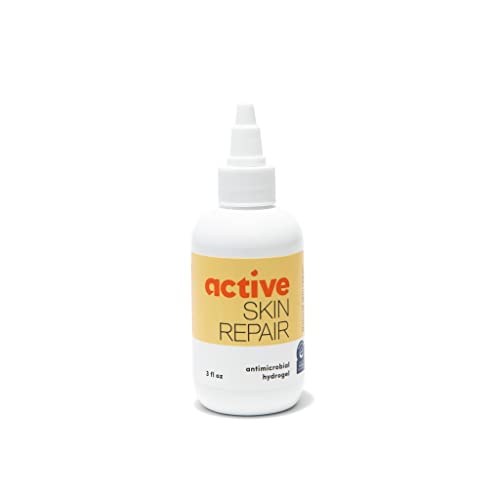
Active Skin Repair's First Aid Hydrogel is a revolutionary product that offers a safe and gentle solution for wound care. The hydrogel technology used in this product is the same as the one used in hospitals and households worldwide, making it a reliable and effective solution for skin care.
The Active Skin Repair Hydrogel is natural and non-toxic, making it a doctor-recommended and clinically-proven solution. It is also non-sensitizing and contains no steroids, synthetic antibiotics, alcohol, or harsh chemicals that may cause skin irritation. This product is safe to use, even for those with sensitive skin.
This versatile product is a daily solution for skin care. It works on cuts, rashes, sunburns, and other skin irritations, providing quick relief and helping the body's natural healing process. The power of a first aid kit is available in a convenient 3oz gel bottle, making it easy to carry and use on the go.
Active Skin Repair's First Aid Hydrogel is tough on germs, making it a medical grade skin solution. It acts quickly to provide relief and support the body's natural healing process, promoting faster recovery from wounds and other skin irritations.
This product is FSA and HSA approved, so you can use your Flexible Spending Account or Health Saving Account card to purchase it. It also has the National Eczema Association Seal of Approval, making it a reliable and safe solution for those with eczema and other skin conditions.
Active Skin Repair offers a money-back guarantee, so you can rest assured that you'll love this product. If you're not satisfied, you can simply return it for a full refund. Overall, Active Skin Repair's First Aid Hydrogel is a must-have in your medicine cabinet, providing a safe, reliable, and effective solution for wound care.
3. Medvance Tm Hydrocolloid – Bordered Hydrocolloid Adhesive Dressing, 4"x4" Box Of 5 Dressings
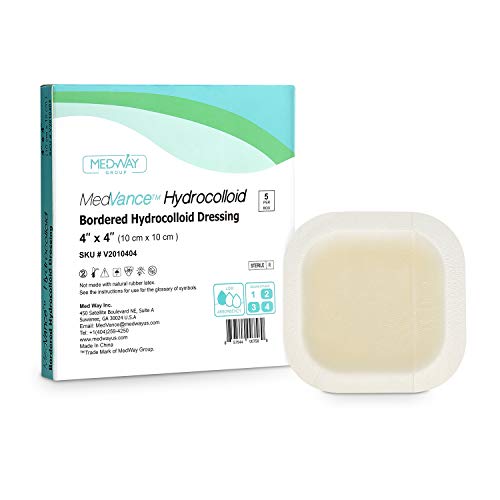
This product is designed to aid in the healing process of various wounds. The use of hydrocolloid in these dressings helps to create a cohesive gel when it comes into contact with wound exudate, providing a moist environment that promotes healing. The bordered hydrocolloid dressings are highly absorbent and comfortable to wear.
One of the benefits of this product is its ease of use. The soft and hypoallergenic adhesive creates a wound contact layer that does not stick to the wound bed but rather to intact skin. This helps to prevent secondary damage and minimizes pain during dressing removal and change.
The semi-permeable PU film acts as a liquid barrier while allowing the passage of oxygen and water vapor. The multilayer structure of the dressings works together to create a highly absorbent yet breathable surface. This keeps the wound moist and sterile, promoting proper healing.
Each dressing is manufactured in a sterile facility and is individually wrapped to prevent contamination of wounds. This makes it an ideal choice for use in hospitals, senior care homes, hospice, and other medical facilities.
This product is versatile and can be used for a variety of applications, including post-operative wounds, bed sores, cysts, pressure ulcers, burns, and other minor traumas. It is also approved for Level II of the Healthcare Common Procedure Coding System (HCPCS), with billing/claims code A6234.
4. Spenco 2nd Skin Squares Soothing Protection, Gel Squares 200-Count, Bacterial Barrier, One Size
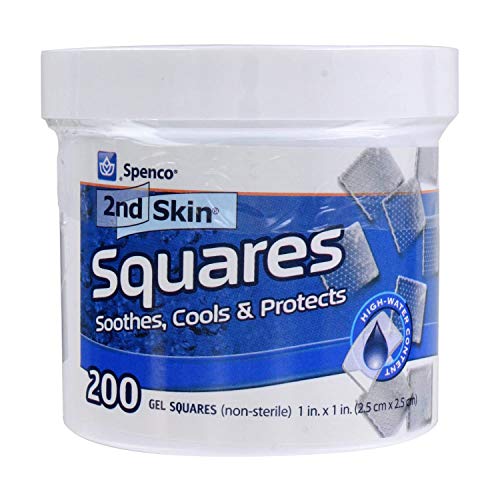
The Medical-grade gel adhesive squares are an essential addition to any first aid kit. These hydrogel squares are designed to soothe, cool, and protect scrapes, cuts and burns. They are hypoallergenic, latex free, and non-medicated, making them suitable for use on all skin types.
Made mostly from water, the dressings will not stick to the skin, ensuring painless removal. These gel squares are ideal for use in clinics, training rooms, and first aid kits.
Each pack contains 200 gel squares that are non-sterile. The squares measure 1 inch x 1 inch / 2.5cm x 2.5cm, making them the perfect size for small wounds.
These medical-grade gel adhesive squares are easy to use and provide a comfortable, protective barrier for wounds. The hydrogel material helps to cool and soothe the affected area, providing relief from pain and discomfort.
5. Rapid Relief Hydrocolloid Bandages – 20 Count
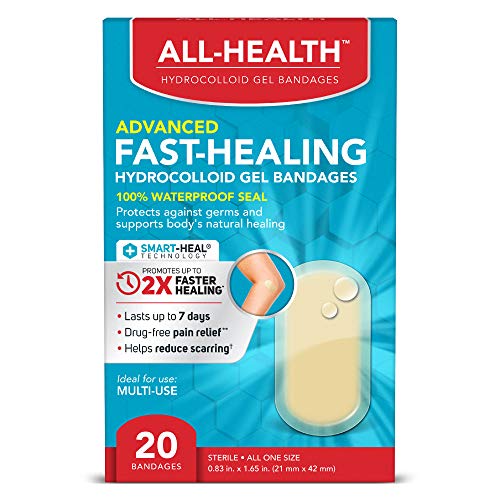
The Smart-heal Technology hydrocolloid bandages are designed to promote faster healing by providing a moist wound environment that supports the natural healing process. This technology has been shown to promote up to 2 times faster healing compared to traditional bandages.
One of the standout features of these bandages is their 100% waterproof seal, which helps to keep the wound clean and dry, even when submerged in water. This makes them an excellent choice for athletes, swimmers, or anyone who wants to maintain an active lifestyle while healing from a wound.
In addition to promoting faster healing, these hydrocolloid bandages also help to reduce scarring. By keeping the wound moist and protected, they create an optimal environment for the skin to regenerate and heal properly.
Another benefit of these bandages is that they offer drug-free pain relief. The moist environment created by the bandages helps to soothe and protect the wound, reducing the need for pain medication.
Finally, these hydrocolloid bandages are designed to last up to 7 times longer than traditional bandages, making them a cost-effective choice for anyone who needs long-term wound care.
With an actual size of 0.83 x 1.65 inches, these bandages are ideal for a variety of wounds, from small cuts and scrapes to larger surgical incisions. They are easy to apply and remove, and their neutral color makes them a discreet choice for any situation.
6. 3m Tegaderm Transparent Film Dressing 2.375" X 2.75"/picture Frame Style/package Of 20
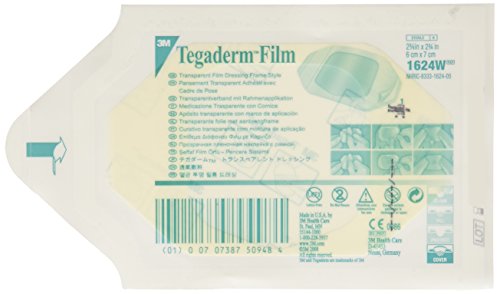
The 3M Healthcare transparent film dressing is an exceptional product designed to protect skin and wound sites. It is factory packaged and not available in retail packaging. The dressing measures 2 3/8" X 2 3/4" (6 x 7 cm) and features a unique window frame design.
This breathable film dressing is impermeable to liquids, bacteria, and viruses, ensuring maximum protection against infections and other harmful elements. It is an ideal solution for individuals with sensitive skin as it is gentle and non-irritating.
The transparent film dressing is easy to apply and is suitable for use on different parts of the body. It provides a clear view of the wound, allowing for easy monitoring of the healing progress without having to remove the dressing.
The product is made from high-quality materials, making it durable and long-lasting. It is a reliable solution for individuals with wounds or skin injuries and can be used in hospitals, clinics, or at home.
7. Nexcare Sensitive Skin Tape, Tears Easily, For Sensitive Skin, 6 Rolls
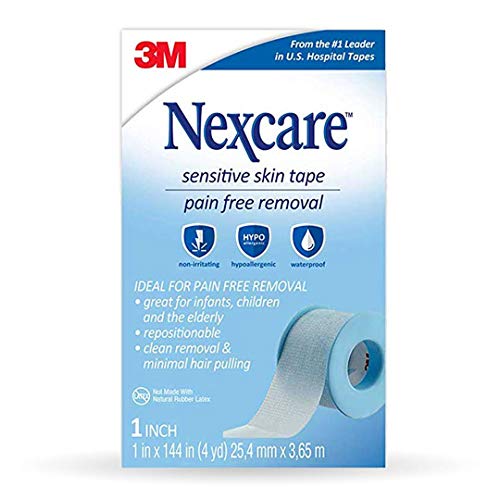
The product being described is an exceptional tape that has gained popularity as the #1 leader in U.S hospital tapes. It offers a pain-free removal experience with minimal hair-pulling, making it an ideal choice for those who have sensitive skin.
The tape is designed to provide excellent adhesion to both skin and dressings, making it perfect for frequent dressing changes. Its water-resistant formula ensures that it stays on even during exercise, providing constant adhesion for as long as it is left in place.
This tape is a reliable choice for those who want a product that can withstand the rigors of daily activities, without worrying about it falling off or losing its adhesive properties. It's easy to apply and delivers maximum comfort, making it a must-have for anyone who wants a pain-free experience while using a tape.
The product is made with high-quality materials that are safe and gentle on the skin, ensuring that it causes no irritation or discomfort. The tape's parameters and specifications make it a standout product in the market, and its water-resistant formula ensures that it can withstand the elements, even in harsh conditions.
8. Clear Cover – 10 Pack – Rescue Essentials
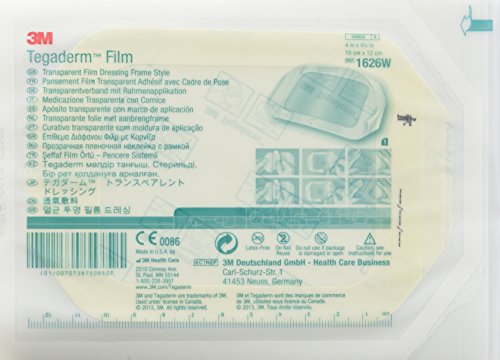
Introducing the transparent film dressing, a sterile and high-quality product designed to provide optimal wound care. This listing offers a convenient pack of 10 dressings per box, each measuring 4 x 4-3/4 inches in an octagon shape. Made with durable film adhesive material, this dressing is designed to adhere securely to the skin, ensuring maximum protection and comfort.
One of the unique features of this transparent film dressing is its frame style, allowing for customization of shape and size to fit any site. This means that the dressing can be easily trimmed to fit any wound size or shape, providing ultimate flexibility and convenience for healthcare professionals and patients alike.
The transparent film dressing is an ideal choice for wound care as it provides a barrier against bacteria and other harmful elements. It is also waterproof and breathable, allowing for optimal healing while protecting the wound from external factors. Its transparent design allows for easy monitoring of the wound without removing the dressing, reducing the risk of infection and promoting faster healing.
9. Flexiderm Ultra-Thin Adhesive Wound Dressing, Box Of 10
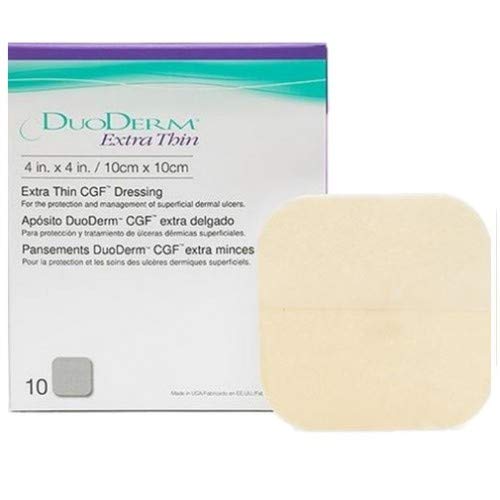
ConvaTec has developed an innovative, highly flexible extra thin control gel formula sterile dressing that provides safe and gentle wound care. These dressings are designed for use on dry to lightly exuding wounds and help skin to heal from the inside out. They are easy to remove and can be worn for up to 7 days.
The dressings use hydrocolloid gel technology that interacts with wound moisture to produce a soft mass that enables removal of the dressing with little or no damage to newly formed skin tissue. This helps to isolate the wound from external contamination, promoting faster healing.
These dressings are incredibly versatile and can be used for a wide variety of purposes such as pressure ulcers, procedure recovery, road rash, cuts & scrapes, blisters, eczema, as an acne patch, or on burns. They are safe and effective for use on any type of wound. Each dressing measures 4 x 4 inches (10 x 10 cm) and the box contains 10 dressings (Pack of 1).
The moldable extra thin dressing is particularly suitable for areas subject to friction and those requiring contouring like ears, knees, elbows, heels, toes, and fingers. They can be cut to size and molded to any area to minimize friction from clothing and bedding.
Each sterile dressing is individually wrapped and manufactured within an FDA registered facility with standard quality control guidelines to ensure patient safety and product sterility. These DuoDERM dressings are trusted by surgeons, physicians, and hospital teams around the globe for their effectiveness and reliability.
Best Dressing For Skin Tear FAQs
Are foam dressings effective for managing skin tears? What are the potential drawbacks?
Foam dressings can be effective for managing skin tears, especially those that are shallow with minimal tissue damage. Foam dressings are designed to absorb excess moisture, and they can help to promote a moist wound environment, which can facilitate faster healing and reduce the risk of infection. Foam dressings are also easy to apply and remove, making them a convenient choice for patients and healthcare professionals alike.
However, there are potential drawbacks to using foam dressings for skin tears. One potential issue is that foam dressings may not be suitable for deeper wounds or those with significant tissue damage, as they may not provide enough protection and support. Additionally, some foam dressings may cause irritation or allergic reactions in some patients, particularly if they contain adhesives or other chemicals.
It is also worth noting that foam dressings can be more expensive than other types of wound dressings, which may be a consideration for patients and healthcare providers looking to manage costs. Overall, while foam dressings can be effective for managing certain types of skin tears, it is important to consider the specific needs and circumstances of each patient before selecting a dressing type.
Can hydrocolloid dressings be used for skin tears? If so, what are the benefits?
Yes, hydrocolloid dressings can be used for skin tears. In fact, they are one of the most commonly used dressings for this type of wound. The benefits of using hydrocolloid dressings for skin tears include providing a moist wound environment, which promotes faster healing and reduces the risk of infection. Additionally, hydrocolloid dressings are designed to conform to the shape of the wound, which helps to minimize pain and discomfort for the patient. They also provide a barrier against external contaminants, such as bacteria and dirt, which helps to prevent further damage to the wound. Another benefit of using hydrocolloid dressings for skin tears is that they are easy to apply and remove, which makes them a convenient option for both patients and healthcare providers. Overall, hydrocolloid dressings are an effective and reliable option for treating skin tears, and are often preferred due to their many benefits.
Can you use transparent film dressings for skin tears? What are the pros and cons?
Transparent film dressings can be used for skin tears, but their use may depend on the location and severity of the tear. These dressings provide a thin, clear layer that allows for visibility of the wound while protecting it from further damage.
One of the main pros of using a transparent film dressing for skin tears is that they are non-invasive and easy to apply. They are also waterproof and can be left on for several days, reducing the need for frequent dressing changes.
However, there are also some cons to consider. If the skin tear is deep or involves exposed tissue, a transparent film may not provide enough protection. Additionally, these dressings can sometimes cause skin irritation or allergic reactions.
It is important to consult with a healthcare professional to determine if a transparent film dressing is appropriate for a particular skin tear. Other factors to consider may include the patient's medical history, the location of the wound, and the potential for infection.
How do you determine the severity of a skin tear and what type of dressing is appropriate?
Determining the severity of a skin tear involves assessing the depth, length, and location of the wound. Superficial skin tears involve only the top layer of skin, while deeper tears may involve muscle, fat, or even bone. Length also plays a role, as longer tears are more likely to require medical attention. Location is important as well, as tears in areas with a lot of movement, such as joints, are more difficult to heal.
Once the severity of the skin tear has been determined, the appropriate dressing can be selected. For superficial tears, a non-adherent dressing such as a silicone sheet or hydrocolloid may be sufficient. Deeper tears may require a moist wound healing environment, which can be achieved with alginate or foam dressings. In some cases, a wound may require sutures or surgical closure.
It is important to seek medical attention if a skin tear is deep, long, or located in a difficult area. A healthcare professional can assess the wound and determine the best course of treatment. Proper wound care is essential for preventing infection and promoting healing.
How do you monitor and manage the healing process of a skin tear with the chosen dressing?
The first step to monitoring and managing the healing process of a skin tear with a chosen dressing is to ensure that the dressing is appropriate for the type and severity of the wound. Once the dressing has been applied, it is important to monitor it regularly for signs of infection, such as redness, swelling, or discharge.
The dressing should be changed according to the manufacturer's instructions or as directed by a healthcare professional. During the dressing change, the wound should be assessed for any changes in size, depth, or color, and any signs of healing or deterioration should be noted.
It is also important to keep the wound area clean and dry between dressing changes, and to avoid any activities that may cause further trauma to the area. Pain management and nutrition are also important factors in the healing process, and should be addressed as needed.
Overall, effective monitoring and management of the healing process of a skin tear with a chosen dressing requires attention to detail, regular assessment, and collaboration with healthcare professionals as needed.
How often should you change the dressing on a skin tear?
It is recommended to change the dressing on a skin tear every 2 days or as directed by a healthcare professional. However, this may vary depending on the severity of the tear and the amount of drainage present. It is important to monitor the skin tear regularly and change the dressing promptly if it becomes wet, soiled, or loose. Additionally, it is essential to use appropriate wound care products and techniques to promote healing and prevent infection. It is recommended to seek medical attention if the skin tear is deep, large, or shows signs of infection such as redness, swelling, warmth, or pus. Proper wound care is crucial to ensure optimal healing and prevent complications.
Should you use antimicrobial dressings for skin tears? What are the potential risks and benefits?
Antimicrobial dressings are frequently used in the treatment of skin tears. These dressings have a range of potential benefits, including reducing the risk of infection, promoting healing, and providing a barrier to external contaminants. They may also help to reduce pain and discomfort associated with skin tears.
However, there are also potential risks associated with the use of antimicrobial dressings. Overuse of these dressings can lead to the development of antibiotic-resistant bacteria, which can be difficult to treat. Additionally, some individuals may experience allergic reactions or other adverse effects from the use of these dressings.
When considering the use of antimicrobial dressings for skin tears, it is important to weigh the potential benefits against the potential risks. In some cases, these dressings may be an appropriate treatment option, particularly for individuals with compromised immune systems or other underlying health conditions. However, in other cases, simpler dressings or other treatment options may be more appropriate. Ultimately, the decision about whether or not to use antimicrobial dressings for skin tears should be made on a case-by-case basis, taking into account the individual's overall health status, the severity of the skin tear, and other relevant factors.
What are the best practices for applying and removing dressings on skin tears?
When it comes to applying and removing dressings on skin tears, there are a few best practices to keep in mind. Firstly, it's important to ensure that the area is clean and dry before applying a dressing. This can be done by gently cleaning the area with saline or another gentle cleansing solution.
When applying the dressing, it's important to ensure that it is the right size for the wound and that it is applied snugly but not too tightly. The dressing should be changed regularly, as per the healthcare provider's instructions.
When removing the dressing, it's important to do so gently and slowly to avoid further damage to the skin tear. If the dressing is sticking to the wound, it can be moistened with saline or another gentle solution to help it come off more easily.
Overall, the key best practices for applying and removing dressings on skin tears involve keeping the area clean, using the right size and type of dressing, and being gentle and careful when handling the wound. Always follow the healthcare provider's instructions and seek medical attention if there are any concerns or complications.
What are the different types of dressings available for skin tears and what are their advantages and disadvantages?
Skin tears are a common type of wound that occur when the skin is ripped or torn. Dressings are an essential component in the management of skin tears, as they help to protect the wound from further damage and promote healing. There are several types of dressings available for skin tears, each with their own advantages and disadvantages.
1. Non-adherent dressings: These dressings are usually made from a non-stick material, such as silicone, and are ideal for wounds with minimal exudate. They are easy to apply and remove, and do not cause trauma to the wound bed. However, they may not provide enough protection for wounds with heavy exudate.
2. Hydrocolloid dressings: These dressings are made from a gel-like substance that forms a protective barrier over the wound. They are ideal for wounds with moderate exudate, and can be left in place for several days. However, they may not be suitable for wounds with heavy exudate or infections.
3. Foam dressings: These dressings are made from a soft, absorbent material that helps to manage exudate and promote healing. They are ideal for wounds with heavy exudate, and can be left in place for several days. However, they may not provide enough protection for wounds with minimal exudate.
4. Alginate dressings: These dressings are made from a seaweed-derived material that forms a gel-like substance when in contact with exudate. They are ideal for wounds with heavy exudate, and can be left in place for several days. However, they may not be suitable for wounds with minimal exudate or infections.
In summary, the choice of dressing for skin tears depends on the amount of exudate, the presence of infection, and the stage of wound healing. It is important to consult with a healthcare professional to determine the most appropriate dressing for each individual case.
What are the key considerations when choosing the best dressing for a skin tear?
When choosing the best dressing for a skin tear, there are several key considerations that should be taken into account. Firstly, the size and location of the tear should be assessed. If the tear is large and on a high-movement area such as a joint, a dressing that is able to stay in place and move with the skin may be necessary. Secondly, the severity of the tear should be considered. If the skin is deeply torn or there is significant bleeding, a more absorbent dressing may be required. Thirdly, the stage of healing should be taken into account. If the wound is in the early stages of healing, a dressing that promotes moisture and healing may be necessary, whereas in later stages a dressing that supports the formation of new skin may be required. Finally, the patient's individual needs and preferences should be considered. Some patients may prefer a more breathable dressing while others may prefer a more protective option. Overall, choosing the best dressing for a skin tear should involve a careful assessment of the wound and consideration of the patient's needs.


